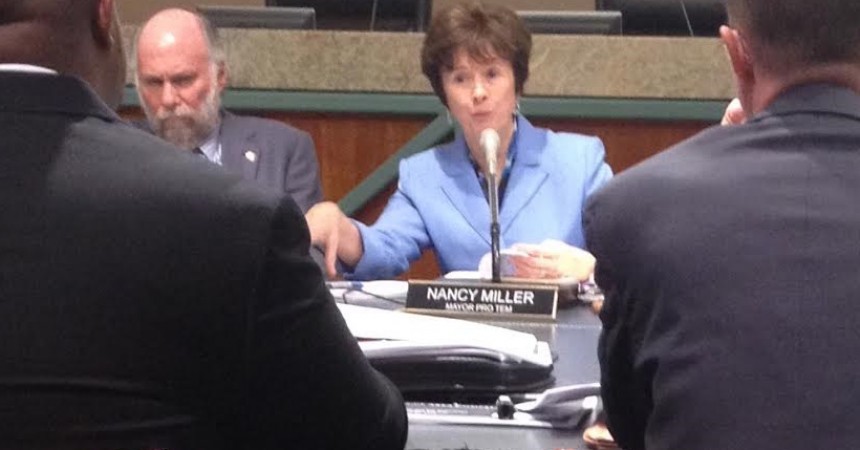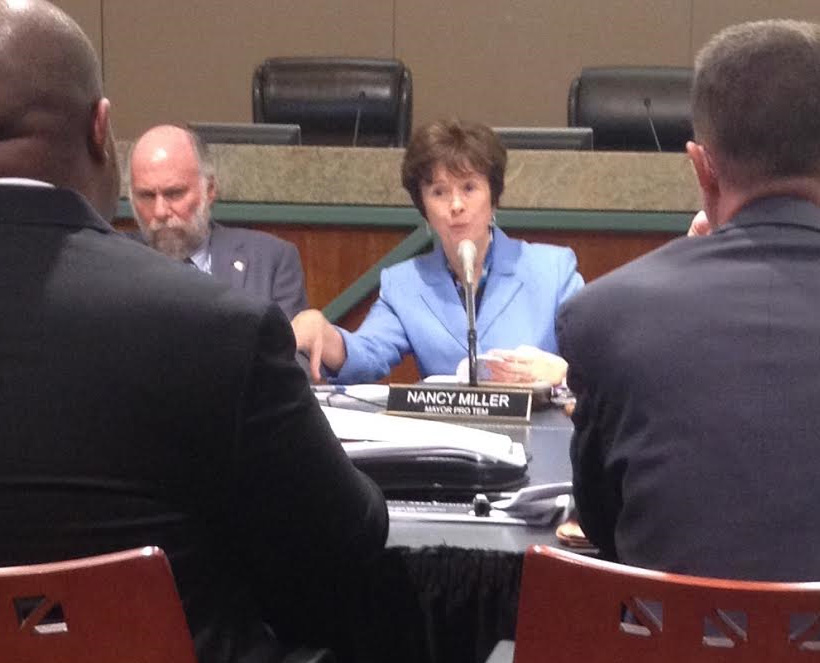
Fixing the Southside

Commissioner Nancy Miller listens attentively while City of Tallahassee staffers present an update on the Southside Strategy Area.
Photo by St. Clair Murraine
[subtitle]
City Commissioners want clarity on boundaries, after latest update
[/subtitle]
By St. Clair Murraine
Outlook staff writer
After watching more than an hour-long presentation of statistics, including boundaries, healthcare and other concerns related to Tallahassee’s Southside, some city commission members told their staff last week that they’d need more specifics and details before continuing to move forward.
The plan, known as the Southside Strategy Area, has been in place since the 1990s. Whether the most affected South City –by crime, poverty and poor housing — should be the sole priority was a major issue with some commissioners.
During the nearly two-hour workshop on the SSA progress, Commissioners also said they wanted to see more prominent leaders involved with a task force formed to develop an approach for correcting social issues in the overall area, which has poor housing conditions, few jobs and a high crime rate.
Commissioner Nancy Miller, who had the most concerns, said she recently spent time on the Southside. What she saw wasn’t clearly reflected in the presentation of maps and statics.
“I think the real issues here are jobs, health and crime,” Miller said. “Right now, looking at all of this, this is very upsetting,” leading the call for finding ways to move forward with development.
“Now that we have it all, we need to consider how we are going to go forward,” she said after the presentation. “We don’t have unlimited resources. We’ve spent quite a bit of money already, not in cash but in human resources. We have to be smarter. We have to figure out what will work.”
Housing was one of her main concerns.
An analysis of Leon County appraisers’ data on housing cost in the area that encompasses the Southside, single family homes are in the range of $61,000. Many of those are aged, according to the report presented.
However, commissioner Curtis Richardson who lives in one of the few affluent areas on the Southside, pointed out that the housing data doesn’t represent the entire area.
“Don’t think that everybody who lives on the Southside of town is impoverished and doesn’t have skills and education,” Richardson said. “Don’t put that out there for anybody to believe.”
Exactly how much was spent on developing residential areas such as the one that’s located near Holton St. and Orange Ave., wasn’t made public at the workshop. However, a recent report states that residents in several Southside communities have been given free energy services and products to the tune of $2.2 million.
Another $2.1 million has been spent on agencies providing services to residents of the Southside Strategy Area.
Miller suggested that doing more partnership housing developments such as one undertaken by Bethel AME Church would be a good way to improve housing. Bethel AME Community Development Corporation, with the assistance of lenders, has been spearheading an initiative to build homes for low-income families.
Richardson agreed with Miller that fixing the housing issue not only needs to be addressed, but it should cover all areas being considered for redevelopment.
“Partnering with the residents, empowering in them to be a part of the solution,” is a workable way to approach the situation, Richardson said. “That’s the only way it’s going to be sustainable.”
That doesn’t just go for housing, but all of the other issues being tackled in the Southside Strategy Area plans, Richardson said.
“If there is not sustainability we will continue to see these same problems exist for a time,” he said. “This has got to be a buy-in by everybody.”
Government studies have shown that unemployment tends to lead to high crime, as is the case in some Southside areas. The unemployment rate in the Southside Strategy Area has fluctuated from 3 percent in 1970 to the latest reported figure of 17 percent in 2010.
Most employers are small business owners like Gloria Pugh, who attended the workshop. She said she would like to see a sense of urgency in moving forward to improve the Southside.
Especially when it comes to crime, poverty and unemployment, she said.
“I want to see what the plans are for the future,” said Pugh, owner of AMWAT Moving Warehousing and Storage. “Not just for the future, but the immediate future and how we are going to address these neighborhoods that are struggling.”
Richardson said the task force that he is spearheading is one way to help get the plans closer to fruition. But commissioner Gil Ziffer questioned its make-up. He said he would like to see the presidents of FSU and FAMU on the panel, although it does include representatives from both universities and Tallahassee Community College.
Mayor Andrew Gillum said not having the presidents on the task force should not affect its effectiveness.
“If we tried to include people at that level,” he said, “we would have been another year trying to get this thing off the ground because they are so busy.”
Richardson agreed, but said there are no quick-fixes to the Southside issues.
“We all have got to be committed to staying the course and not think that we can go in with a program or some fancy title and we are going to change the thing overnight,” he said. “We didn’t get here overnight; we’re not going to change it overnight.”







